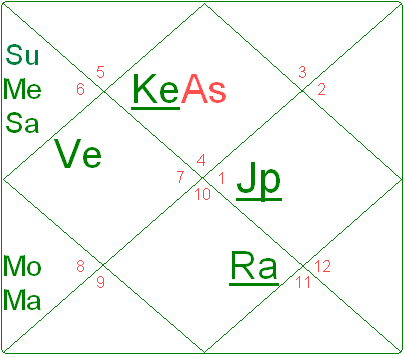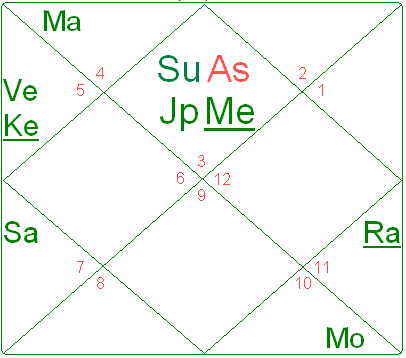Spring | Summer | Fall | Winter | |
2025 | Volume 67 |
| Volume 65 | Volume 66 |
Volume 5, June 20 2009
“Love is to the heart what the summer is to the farmer's year - it brings to harvest all the loveliest flowers of the soul.”
Jyotisha Basics Seminar
Proper Motion, Diurnal Motion and the Summer Sky
Summer makes for wonderful viewing of the night sky with balmy temperatures and a holiday spirit. It is probably a very good time to introduce the concept of proper and diurnal motion so you can enjoy your star gazing with more awareness and appreciaton of the order of the cosmos.
Bearing in mind that our observations are geocentric (i.e.we fix the Earth as stationary), diurnal motion is the APPARENT movement of the heavens and the planets from East to West. It is really the Earth's rotation on its axis which is a West to East rotation that causes this phenomenon.
Let's Keep our discussion limited to the Northern Hemisphere for the sake of clarity. Pick a lovely summer evening when the Moon is full or almost full. I suggest July 7th since it is right around the very special Guru Purnima, the time for honoring the preceptors of this tradition.
At sunset or shortly thereafter, you will see the full Moon rising on the Eastern horizon. Look to the South at hourly intervals after sunset and you will see the full Moon which is in the constellation of Sagittarius (according to the Sidereal zodiac) rising higher and higher in the sky as the wheel of the zodiac rotates from East to West. After it is at its highest point, it follows the arc downward to the West and if you are up very late, you can watch it disappear below the Western horizon. Welcome to diurnal motion. All of the constellations and planets follow this pattern.
If you keep observing the Moon over several nights, you might discover the next important motion which is proper motion. The grahas seem to wander eastward as seen from planet Earth (i.e. travel from West to East) through the backdrop of the 12 constellations. The rate at which they move varies with each graha. Some move very slowly like Saturn and some move quickly. The Moon is the speediest of all. Proper motion can be confusing because it is in the opposite direction from diurnal motion. However, think of diurnal motion as relating to the bhavas or houses tying down a particular cosmic kaleidoscope pattern to a moment in time. Proper motion describes a graha with respect to the constellation it is moving through.
Sometime around 10:00 PM EDT on August 3rd (when you should be sleeping!) notice the very bright Jupiter above the horizon in the Southeast. An almost full Moon will be near the midheaven. Observe which side of Jupiter (to the East or to the West) the Moon is on. Then look at the two on the next few nights a bit later each consecutive night until the 8th of August. What has happened to the relative positions of Jupiter and the Moon? Let me know what you think!!
Enjoy the summer skies!!
The Path Into Shastra
Part II
Beginnings and Endings
Every good orator, lecturer, lawyer, author, composer and teacher knows that you have to start off with impact and end with impact. If you are really good at your craft, you also know that what you say or write or compose must have an internal consistency that does not violate what you have stated at the beginning or close with at the end.
A good example of this principle comes from the world of music. Most everyone is familiar with Beethoven's fifth symphony and its powerful but unsettling opening notes. This opening motif is written in C-Minor creating the "storm clouds" that give the composition its emotional impact. Everything that follows is magnificently woven into and integrated with that opening theme. It is a masterpiece with no note out of place - everything belongs and works together. The pure genius of Beethoven is reflected even more in the ending. He resolves the whole angst of the work when he modulates the key to C-Major. It is as if the storm clouds have parted and human hope and spirit triumph having garnered wisdom from the journey.
The first golden key to understanding not just Jyotisha shastra (precepts and principles) but of all the works in the Vedic tradition is exactly the above principle. Shastra will state something at the beginning of the work or a chapter or a group of verses and that statement should cause the alert reader to sit up and take notice. It is the signal that this is a seminal idea which carries great weight. The same careful observance should be given to the ending statement. Those who scan through a chapter or book and never get to the close will likely miss the emphasis and priority the seer intends. The technical term for this principle in Sanskrit is "upakrama upasamharaikya" or "upakramopasamharaikya"
It is important to remember that shastra is written in Sanskrit and in a script that does not have italics, underlining, capitalization etc. Emphasis had to be created in other ways. If we are not initiated into the ways emphasis gets structured in shastra, we are impoverished in our ability to understand and utilize it properly. Unfortunately, this is often true of Vedic Astrology as it is practiced in the West (See Part I Understanding Shastra). Many times the importance of the root principles as signaled by the golden keys of understanding shastra is not reflected in the interpretations of the charts.
Some examples will be helpful to clarify this idea. All shastra in the Vedic tradition including the revealed works on Jyotisha opens with an invocation. The deity may vary but an acknowledgment of the divine source is invariably there at the outset. If we check out the end of these works, we also find the same. This is a flat out statement that Jyotisha is a divine subject whose purpose is to help relieve human suffering. Anyone who states that Vedic Astrology is simply "mundane" or just "predictive" misses this point entirely.
In Brihat Parashara Hora Shastra, a work that is considered to be the root material for Jyotisha, the sage beautifully illustrates this principle. He begins with an invocation to Lord Ganesha and goes on to show how Jyotisha is placed at the heart of the oral Vedic tradition. He models for his disciple Maitreya the proper respect one gives to the source of knowledge before giving it out and then descrbes to him the qualities that the tradition requires the student to possess to be worthy of being taught this sacred subject. This is all repeated at the end of the work as well.
Parashara follows these opening versus with the inspirational insights of this tradition into the creation and cosmology of the universe and its ultimate source. It is only after giving this context that he starts to unfold in the third chapter what we consider to be astronomical and astrological information.
The astute reader will find that in this third chapter, the first heavenly bodies that are referred to are the fixed star groups known as nakshatras representing that which does not move, change or decay and then the grahas (planets) that move between the earth and the fixed bands of stars are enumerated.
As soon as Parashara states the names of the grahas, he immediately follows with a shloka defining which ones are the natural benefics and which are the natural malefics. This is the first indication of material that is interpretive in nature. In "modern" Jyotisha, it has become the trend to emphasize a concept known as functional benefics and functional malefics where a particular planet is categorized as benefic or malefic not based on its inherent nature, but rather based on the particular rising sign or constellation under consideration
Where does Parashara explain this concept of functional benefics and malefics? Depending on what edition of this work one owns, it is somewhere around chapter 34! Clearly the classification of natural benefics and malefics has much greater emphasis as shown by its position in the work as the very first descriptive statement of the inherent nature of the grahas.
Without knowing this first golden key, a Jyotishi could be haphazard about which "kind" of benefic or malefic they will primarily use in chart interpretation and unfortunately, that is the case not only in chart readings but in the books and teachings by primarily Western Jyotishis who don't have direct access to the oral tradition and Sanskrit. There is another golden key that comes later that deals with unique subject matter like chapter 34 and properly used, it is powerful material. However, it is not the FIRST golden key which already is a reiteration of its relative importance.

A concrete chart example of the difference this could make in an interpretation should drive the importance of this principle home. Here is the chart of Christopher Reeve. Note the beautiful Venus in his fourth house which is in its own rashi of Libra and also has directional strength (dig bala). For those of you that have more experience in Jyotisha, you will see it is forming a powerful Malavya Yoga (beauty, arts, wealth, refinement) as well as Raja and Dhana yogas (fame and wealth). In the classification of natural benefics and natural malefics, Venus is a first rate benefic. However, if you consult chapter 34, you will see that Venus is a malefic for a Cancer ascendant. If you prioritize incorrectly, you have no way to explain salient features of his life. It was in his Venus dasha that he rose to dizzying heights of fame through his Superman movies and made his fortune. He was born in a wealthy family with a society mother who was beautiful and was herself well versed in the arts. Furthermore, he had an excellent education at private schools, Cornell University and Julliard - all shown by the beautiful placement of Venus in his chart.

If we consider the chart of Carl Orff , we find a very powerful Mercury in the ascendant with the Sun and a powerful Jupiter. Consulting Parashara, we find that Jupiter is the best of the natural benefics. Mercury also is acting as a natural benefic in this chart as per Parashara's definition and when a strong Jupiter influences Mercury, it elevates its benefic tendencies. However, if we consult chapter 34 we find that the only auspicious graha for a Gemini ascendant is Venus!! Moreover, Jupiter which powerfully influences the ascendant and ascendant lord is regarded as a malefic. How can this account for a man who is famed for his teaching (Jupiter) methods that have influenced countless children (Jupiter) all over the world? He has written and published music and books (Jupiter, Mercury). How can this account for his brilliant career (Jupiter) and the fact that he lived to 87 years old with such a "malefic" Jupiter in his ascendant?
Clearly there is a wealth of information about how to prioritize the material in shastra that one can glean from using this first of the six golden keys for understanding shastra. Watch for the rest in newsletters to come.
The Media Corner - Kalamrita:Immortal Vedic Wisdom For Every Day Life
Kalamrita means immortal time or the nectar of time.What a lovely name for this unique offering from the Mata Amritanandamayi Center (Ammachi) Center.As we plan our day, why not simultaneously cultivate being in sync with natural law? This is the premise of Kalamrita which brings together a useful daily/weekly planner for 2010 along with some of the elements of the Indian Panchanga - the five-fold "almanac" that helps us more successfully navigate our world with relation to time.
Along with the very user friendly information of following the movements of the planets through the weeks, Kalamrita is packed with lovely stories and pictures of the deity to whom this inaugural year is dedicated - Lord Ganesha. In addition, there are interesting articles on many aspects of the Vedic tradition.
As the welcome page itself states, Kalamrita is offered to "lovers of the Vedic Tradition and its auxiliary branches.Those who follow Vedic holidays, those who love yoga and those who are interested in Jyotisha will all benefit from the use of this almanac".
Available from the MA Center in San Ramon (510-537-9417)












